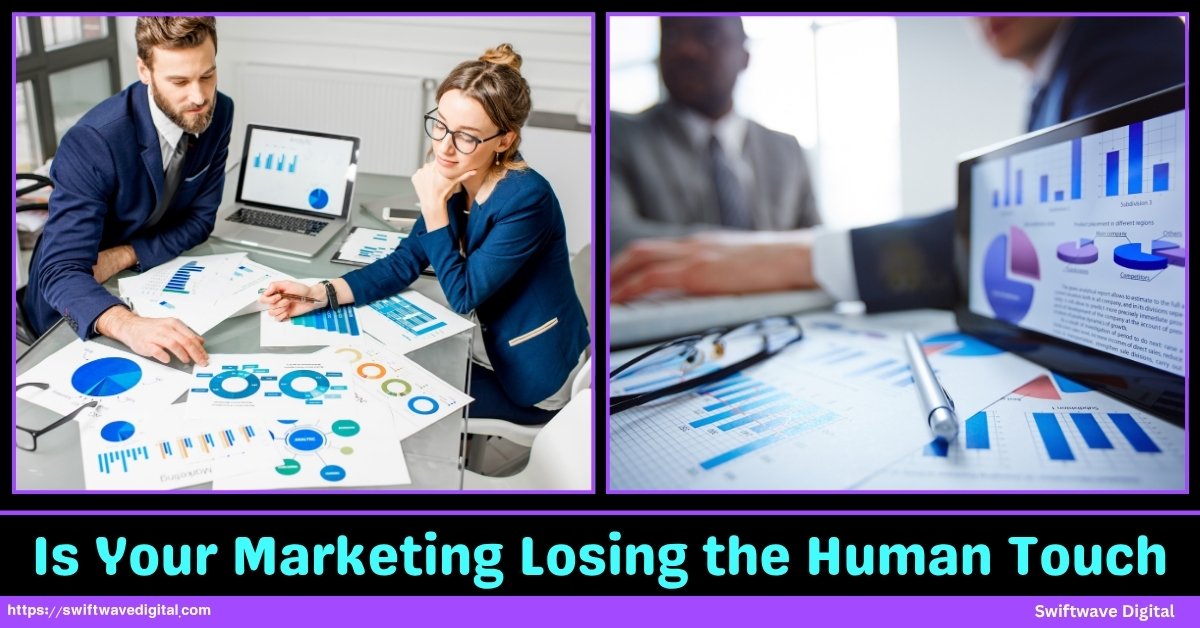Marketing today is evolving faster than ever with automation, AI, and data-driven tools reshaping how brands reach their audiences. But somewhere in the rush for clicks, conversions, and efficiency, many businesses have lost something vital the human touch.
Customers no longer respond to cold emails or robotic ads; they crave authenticity, empathy, and genuine connection. A campaign may be technically perfect, but if it feels impersonal, it fails to resonate.
In a world overloaded with content and noise, human-centered marketing is no longer optional it’s essential for trust, loyalty, and long-term success.
Is Your Marketing Losing the Human Touch
In this guide, we will explain how to recognize when your Marketing has lost its human touch and the exact steps to bring it back.
Automation Overload: When Efficiency Kills Emotion
Marketing automation tools have become a backbone for modern brands. From email workflows to chatbots, they help teams save time, reduce manual effort, and maintain consistency.
However, when overused, automation removes the emotional connection that makes marketing effective. Customers can easily tell when a message is machine-generated or overly templated.
When every campaign follows the same structure and tone, your brand becomes predictable — and forgettable. Automation should support creativity, not replace it.
To avoid losing the human touch, marketers must design automated systems that still feel personal. Use real names, conversational language, and context-aware messaging.
Review automated responses regularly and ensure they align with human communication patterns.
True personalization is not just about inserting a name in an email; it’s about addressing needs, behavior, and timing. Automation should be invisible — it should feel like a genuine conversation, not a script.
Data Without Depth: The Danger of Over-Reliance on Metrics
Data drives modern marketing decisions, but too much dependence on numbers can make campaigns lifeless. Metrics like clicks, reach, and conversion rates are important, but they don’t tell the full story.
Data reveals patterns, not emotions. When marketing focuses only on performance metrics, it risks ignoring what truly motivates human behavior — trust, emotion, and storytelling.
Numbers should guide strategy, not define it. The real question isn’t just what worked, but why it worked. Marketers should blend quantitative data with qualitative insights like customer feedback, reviews, and sentiment.
Data can tell you what people do, but empathy helps you understand why they do it. To stay human-centered, review metrics with a purpose: use data to identify pain points, not just optimize conversions.
The most effective marketing uses numbers to support decisions, not replace human intuition.
AI Content Fatigue: When Everything Sounds the Same
AI-generated content has flooded digital platforms, making marketing faster but less personal. When dozens of brands use similar prompts and AI tools, the output becomes repetitive.
The same tone, phrases, and structure appear everywhere, leading to what many call “AI content fatigue.” Consumers quickly notice this sameness — it lacks originality and emotional depth.
AI can be an excellent assistant for structuring ideas or speeding up production, but it should never replace the creative thinking that only humans provide. To maintain authenticity, marketers should use AI for support and humans for storytelling.
Add personal experience, real-world insight, and emotional tone that AI cannot replicate. Always review AI drafts for personality and flow.
A human edit ensures your content speaks with intention, not prediction. The most successful brands use technology to enhance their human voice, not silence it.
Social Media: Engagement Without Connection
Social media was meant to connect people, but it’s now overloaded with corporate content that feels empty. Brands chase engagement metrics likes, shares, impressions but forget about meaningful connection.
A polished post may perform well with algorithms, yet still feel robotic to audiences. People want authenticity, not perfection. They want to see behind-the-scenes moments, real opinions, and relatable communication.
To rebuild the human touch on social platforms, marketers need to talk with their audience, not at them.
Respond to comments personally, ask questions, and show gratitude publicly. Use fewer pre-scheduled posts and more spontaneous, conversational updates. The goal isn’t to dominate timelines it’s to build trust through consistency and honesty.
When audiences feel heard, they engage more naturally. Real engagement happens when people feel they’re part of the story, not just the target of an ad.
Customer Experience Gap
A major reason marketing loses its human element is poor customer experience. Brands spend huge budgets attracting customers, but often fail to deliver a seamless, human-centered journey afterward.
Automated responses, long waiting times, and generic service scripts make customers feel unimportant. The experience from the first ad to post-purchase support should feel continuous and personal.
Every interaction website visit, inquiry, or delivery contributes to how customers perceive your brand. To bridge this gap, focus on empathy-driven design.
Train teams to listen before replying. Simplify processes so customers don’t feel trapped in automated loops.
Gather feedback regularly and act on it. A human-centered experience doesn’t always require more staff it requires better understanding of real customer needs.
When customers feel seen and respected, loyalty naturally follows. Good marketing doesn’t end at conversion; it begins there.
Storytelling: The Core of Human Marketing
At its heart, marketing is about stories not sales pitches. Facts and features may inform, but stories inspire. A powerful story triggers emotion, builds connection, and makes your brand memorable.
Storytelling doesn’t mean writing novels or exaggerating details; it means presenting real experiences in a way that resonates. Use simple language and focus on the human impact behind your product or service.
Explain how it solves problems, improves lives, or supports communities. Avoid making your brand the hero — make the customer the main character.
The role of the brand is to guide, support, and empower. Whether it’s a social media caption or a long-form campaign, start with emotion, then move to logic.
The best marketing stories make people feel something first, then think about action. Remember, people forget data but remember how a message made them feel.
How to Bring the Human Touch Back
Reintroducing humanity into your marketing doesn’t require massive change — just conscious effort. Start by simplifying your communication. Write like you speak.
Replace jargon with clarity and sincerity. Personalize messages based on context, not just demographics. Instead of pushing offers, share value. Give before you ask.
Listen more analyze feedback, comments, and reviews to understand what your audience truly cares about. Humanize your brand voice by showing real people behind the business founders, employees, or satisfied customers.
Show emotion, even vulnerability, when appropriate. Admit mistakes publicly and share how you’re improving. Use technology wisely: let AI handle repetition, but keep creative control human.
The human touch means being consistent, transparent, and empathetic — not perfect. When marketing feels real, audiences respond naturally. Connection grows when customers sense your brand cares beyond the sale.
Future of Marketing: Technology with Humanity
The future of marketing is not about choosing between technology and humanity it’s about merging them effectively. Automation, AI, and analytics will continue to evolve, but they should serve human goals, not replace them.
The next generation of marketing will focus on experience intelligence using data to understand people’s emotions, not just their actions. Brands that thrive will be those that communicate with empathy while leveraging smart tools for precision.
The challenge is balance: too much technology creates distance, too much emotion loses structure. The solution lies in integration — where human creativity directs technology’s power.
In this future, trust and transparency will outweigh mere visibility. Consumers will choose brands that feel authentic and act responsibly.
The human element will become the strongest competitive advantage, proving that progress doesn’t mean losing connection. Real success will belong to marketers who stay human in a digital world.
Conclusion
Marketing has advanced faster than ever, but progress means nothing if it disconnects from people. Every click, email, and campaign should remind the audience that there’s a real person behind the brand.
Technology can amplify your message, but only human emotion makes it meaningful. The most effective marketing is not the one with the highest automation or biggest budget it’s the one that feels honest, personal, and empathetic.
As businesses compete in crowded digital spaces, the human touch becomes the ultimate differentiator. Stay data-smart, but heart-led. Use AI as a tool, not a voice.
Keep your focus on what truly drives loyalty connection, trust, and understanding. Because at the end of the day, it’s not machines that build relationships it’s humans.




